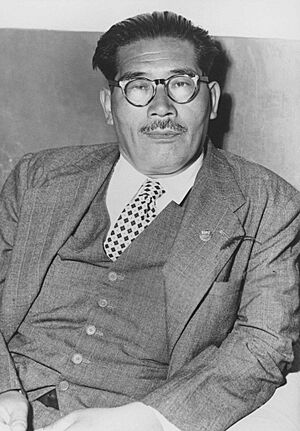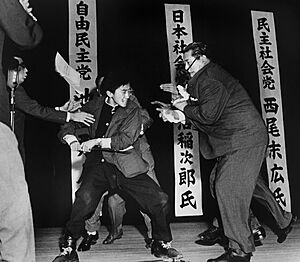Inejirō Asanuma facts for kids
Quick facts for kids
Inejirō Asanuma
浅沼 稲次郎 |
|
|---|---|

Asanuma in 1952
|
|
| Chairman of the Japan Socialist Party | |
| In office 23 March 1960 – 12 October 1960 |
|
| Preceded by | Suzuki Mosaburō |
| Succeeded by | Jōtarō Kawakami Saburo Eda (acting) |
| General Secretary of the Japan Socialist Party | |
| In office 13 October 1955 – 23 March 1960 |
|
| Preceded by | Position created |
| Succeeded by | Saburo Eda |
| Member of the Japanese House of Representatives from Tokyo 1st district | |
| In office 11 April 1946 – 12 October 1960 |
|
| In office 21 February 1936 – 30 April 1942 |
|
| Personal details | |
| Born | 27 December 1898 Miyake-jima, Tokyo, Empire of Japan |
| Died | 12 October 1960 (aged 61) Chiyoda, Tokyo, Japan |
| Cause of death | Assassination |
| Resting place | Tama Cemetery, Tokyo, Japan |
| Political party | Japan Socialist Party |
| Other political affiliations |
Imperial Rule Assistance Association (1940–1942) |
| Alma mater | Waseda University |
| Occupation | Politician |
Inejiro Asanuma (浅沼 稲次郎, Asanuma Inejirō, 27 December 1898 – 12 October 1960) was an important Japanese politician. He led the Japan Socialist Party, a major political group in Japan.
During World War II, Asanuma supported Japan's actions in Asia. After the war, he became a strong supporter of socialism in Japan. He was known for supporting the new People's Republic of China. He also openly criticized the United States–Japanese relations. This made him a very talked-about figure in Japan.
Sadly, Asanuma was killed by a far-right nationalist named Otoya Yamaguchi. This happened while Asanuma was speaking in a political debate on TV in Tokyo.
Early Life and Education
Inejirō Asanuma was born on December 27, 1898. He was born on Miyake-jima, a small volcanic island near Tokyo. His mother passed away when he was born. His father raised him, but later also passed away from cancer. This left Asanuma an orphan.
After finishing high school, Asanuma went to Waseda University. He graduated in 1923. While in college, he joined the new Farmer-Labour Party. He was involved in many activities to help workers and farmers. For example, he started a group called the "Builders League." This group studied the ideas of English socialists. He also helped with aid for a famine in Russia. In 1924, he left the Farmer-Labor Party and worked with tenant farmers and the labor movement.
Political Career in Japan
In 1926, Asanuma helped create the Japan Labour-Farmer Party. He wanted to connect city workers with farmers in the countryside. In 1929, he started running for the Tokyo City Council. He was elected in 1933.
In 1936, Asanuma was elected to the National Diet of Japan for the first time. The Diet is Japan's national parliament. He was a member of the Social Masses Party. This party later joined the Imperial Rule Assistance Association in 1940. Asanuma served in the Diet for a total of 20 years.
As a Diet member, Asanuma changed his views. He had once been against imperialism, but he began to support Japan's "holy war" in East Asia. He said it was needed to free Asia from Western control. He even pushed to remove another politician, Saitō Takao, from the Social Masses Party. This happened after Saitō gave an anti-war speech in the Diet in 1940. Asanuma chose not to run for re-election in 1942.
After Japan lost World War II, Asanuma helped start the Japan Socialist Party (JSP). He became its secretary-general from 1955 to 1960. Then, in 1960, he became the party chairman. Asanuma was seen as an "everyman" politician. He lived simply and was popular with ordinary workers and small business owners.
After the war, Asanuma strongly opposed changing Article 9 of Japan's constitution. This article prevents Japan from having a military that can wage war. He was against Japan becoming a military power again. Historian Andrew Gordon says Asanuma always disliked Western influence and wanted Asia to decide its own future.
In 1959, Asanuma visited the People's Republic of China. During a speech in Beijing, he called the United States of America "the shared enemy of China and Japan." This caused a lot of criticism. When he returned to Japan, he wore a Mao suit, which even upset some Socialist leaders. At that time, Japan and the U.S. recognized the Republic of China (Taiwan) as the true government of China.
Under Asanuma's leadership, the JSP played a big role in the huge Anpo protests in 1960. These protests were against changing the U.S.-Japan Security Treaty. The protests led to the resignation of Prime Minister Nobusuke Kishi. This angered right-wing groups who supported the treaty.
Assassination
On October 12, 1960, Inejirō Asanuma was killed. He was stabbed by a 17-year-old right-wing nationalist named Otoya Yamaguchi. This happened during a political debate that was being shown live on television. The debate was for upcoming elections for the House of Representatives.
A photograph of Asanuma's assassination was taken by Yasushi Nagao. This photo won him both the Pulitzer Prize and the World Press Photo of the Year. Yamaguchi was caught right after the attack. He died a few weeks later while in police custody.
Commemoration
Asanuma's death shocked many people in Japanese politics. Soon after he died, Prime Minister Hayato Ikeda, who was a political rival, gave a heartfelt speech about Asanuma in the Diet. Ikeda called Asanuma a "speech-giving everyman." He said:
You made service to the people the core of your political principles. You were always speaking directly to people with amazing skill and passion.
’Numa truly is a speech-giving everyman
With his soiled clothes and tattered briefcase;
Today in this public hall,
Tomorrow at a roadside temple in Kyoto.
This is what Asanuma’s friends used to sing about him in the 1920s. Even after he became Chairman, he never stopped being this "speech-making everyman." We all remember him giving speeches everywhere in the country.
Reports from that time said that Ikeda's speech received loud applause. Many lawmakers were moved to tears.
Legacy
The Japan Socialist Party was a mix of different socialist groups. They had come together to oppose the joining of conservative parties into the Liberal Democratic Party in 1955. Asanuma was good at keeping these different groups united. Under his leadership, the party won more seats in the Diet in the late 1950s. It seemed like they were gaining strength.
Asanuma's death meant the party lost his strong leadership. Saburō Eda took over as leader. Eda was more moderate, and he quickly moved the party in a more central direction. This was faster than some left-wing socialists were ready for. This led to more arguments within the party. It also made it harder for the party to share a clear message with the public. Over the rest of the 1960s and beyond, the number of seats the Socialists held in the Diet kept going down. The party eventually ended in 1996.


